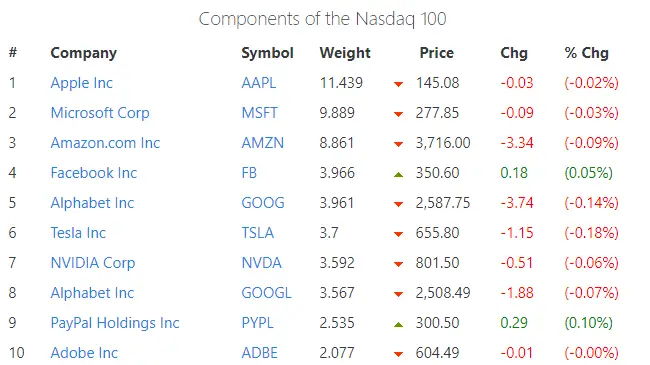Stock market indices are typically used to measure the performance of a particular stock market and with each component or segment benchmarking their performance against it. A capitalization-weighted index is a similar concept that accounts for each component of the index with respect to its market capitalization.
Market capitalization (or simply market cap) is a widely used measure by analysts. A capitalization-weighted Index (CWI) uses the total market cap of each component of the index and assigns a weightage in the index.
Many of the top US stock markets use a CWI, such as the NASDAQ, S&P 500, and Wilshire 500 are prominent examples of capitalization-weighted indices.
What is a Capitalization-Weighted Index?
A Capitalization-Weighted Index is a stock market index that assigns percentage weightage to each component based on its market capitalization.
We can calculate the market capitalization by multiplying the total number of outstanding shares with the current share price of a company. It is a metric that is widely used to measure the stock market’s performance. Hence, assigning weightage according to a company’s market cap makes sense for many analysts.
Understanding Capitalization-Weighted Index
Stock market indices are used to provide a yardstick of the market’s performance. A capitalization-weighted index uses market capitalization as the yardstick to analyze the performance of the subset of a stock market. It weighs the components based on their respective capitalization weightage. Thus, a company with a higher market cap will have higher weightage in a CWI.
The number of outstanding shares and share prices change continuously for public companies. A large movement in a company’s share prices can have a large impact on its weightage in the CWI. Therefore, a company with a larger market cap (and eventually larger weightage) will have a greater impact on the index’s performance as compared to a small-cap company.
Working Example and Formula to Calculate Weightage in a CWI
Capitalization-weighted indices consider the market capitalization of each of their components as a yardstick of performance. Thus, established companies with larger market caps will have a bigger say in the CWI performance of a stock exchange.

Unsurprisingly, companies with the largest market caps have a larger proportion of weightage in the NASDAQ 100 index. This index is one of the popular capitalization-weight indices in the world. As we can see, its top 10 components are also the largest companies by market capitalization.
We can understand the CWI working with the help of a simple example and its working formula.
CWI Formula,
CWI = W1P1 + W2P2 + W3P3 …. + WnPN.
Where :
W = Weight of the stock
P = Price of the stock
Weight of the security = Market Cap of the Security ÷ Total Market Cap of the Index
Let us consider an example of a hypothetical CWI with only 5 components.
| Stock | No. Of Shares | Share Price | Market Cap | Weightage Sn/total M. Cap |
|---|---|---|---|---|
| S1 | 100,000 | $ 25 | $ 2,500,000 | 8.06% |
| S2 | 200,000 | $ 40 | $ 8,000,000 | 25.8% |
| S3 | 500,000 | $ 30 | $ 15,000,000 | 48.3% |
| S4 | 75,000 | $ 20 | $ 1,500,000 | 4.83% |
| S5 | 100,000 | $ 40 | $ 4,000,000 | 12.9% |
| Total | $ 31,000,000 | 100% |
As we can see the company S3 with the largest market cap has the largest weightage in the CWI. Similarly, the company S4 with the smallest market Cap represents the lowest weightage in the CWI.
Hence, a change in the price of the largest component will affect the CWI more than the smaller weightage components.
Important Considerations with Capitalization-Weighted Index
In the calculation of market cap and hence the CWI weightage, only the common outstanding shares available to the public are considered. It is called the free float factor.
Some critics argue that the CWI is more inclined towards the performance of the larger companies. It solely takes into account the market cap that can be an unfair metric of performance to smaller companies. Thus, a CWI’s performance will be more affected by the market cap of a few larger companies than the better performance of many smaller ones.
Measuring CWI performance through market cap can also have its consistent advantages. For instance, companies with lower market caps tend to have limited financial resources. Hence, the bad performance of these companies will have a less risky impact on the CWI’s total performance.
Pros of Using a Capitalization-Weighted Index
The capitalization-weighted index provides some useful metrics for investors and analysts to evaluate the performance of a subset of the stock exchange.
- Capitalization-weighted index is one of the most commonly used and accessible metrics.
- A CWI includes a wide range of large and small companies to assess the market performance overall.
- As larger and established companies have a greater weightage, the index becomes less volatile.
- Smaller companies with weaker financial performance have a less risky impact on the overall performance of the index.
Cons of Using a Capitalization-Weighted Index
The capitalization-weighted index also presents its limitations.
- Companies with overvalued stock prices can have a disproportionate impact on the index’s performance.
- Larger companies may gain more weightage in the index with a sudden share price appreciation.
- The addition of excessively overvalued stock components can create a stock market bubble.
- The performance of smaller companies does not reflect properly even if they outperform larger companies.
Final Thoughts
A capitalization-weighted index is one of the most widely used index metrics around. Investors and analysts can use a CWI to analyze the performance of a stock market segment. However, it can sometimes give more weightage to overvalued stocks and can create misleading information.
